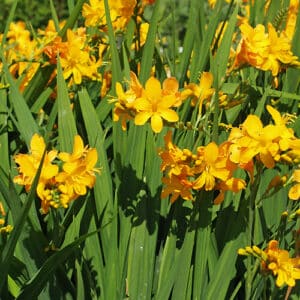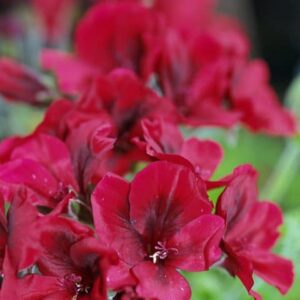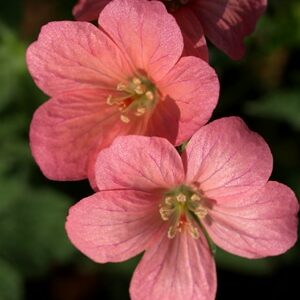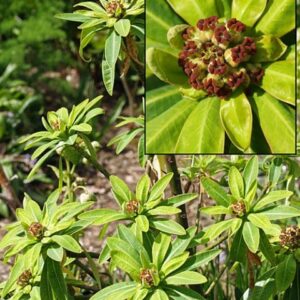Years ago – maybe as far back as 1985 – Anne Jenner took a census of HPS members favourite plants, or maybe it was their most wanted plants or what they were growing, but anyway, she took a census and to her surprise euphorbias were right there at the top of the average list. I don’t think they’ve decreased in popularity since. Or, maybe they simply haven’t died.
It’s a very large genus dominating the family Euphorbiaceae. They grow worldwide as annuals, perennials, succulents and even trees. Sometimes they’re weeds or behave like weeds. Some are evergreen and some herbaceous. Sometimes they’re grown as houseplants like poinsettias and crown of thorns.
In gardens they’re grown for three principal reasons – their flowers which are usually spring flowering and greenish yellow, their architectural forms (what could be more dramatic than the weed Euphorbia lathyris the caper spurge) and their foliage. They mostly come from dry or seasonally dry environments which leads to several useful attributes – drought tolerance, pale foliage to reflect solar radiation and winter activeness. They don’t live forever usually becoming old and woody, looking dishevelled and scrappy and thin on top – like old men. I take cuttings – the best are small side shoots that grow below mature seed heads. Almost all the common garden forms are scented – a pervasive heavy scent of honey – a little boring as scents go but you can almost bathe in it.
EUPHORBIA CHARACIAS
Take the one which is most important to me – Euphorbia characias. These are typically Mediterranean coming from the east (SW France to Turkey) with yellower flowers (subspecies wulfenii) and the west Mediterranean (Portugal to Crete) with green flowers (subspecies characias). Britain suits them. It’s not as cold as the Med can be in winter and they cope with wet summers (but not so well in Cornwall, Kerry and Kintyre). I’ve found them to be good plants for dry shade under trees particularly if moderate light penetrates at some time in the day. A montane form of the western one has been called ‘Portuguese Velvet’ – it’s squat and hairy and when all my other kinds died in the winter of 2010-2011 it didn’t.
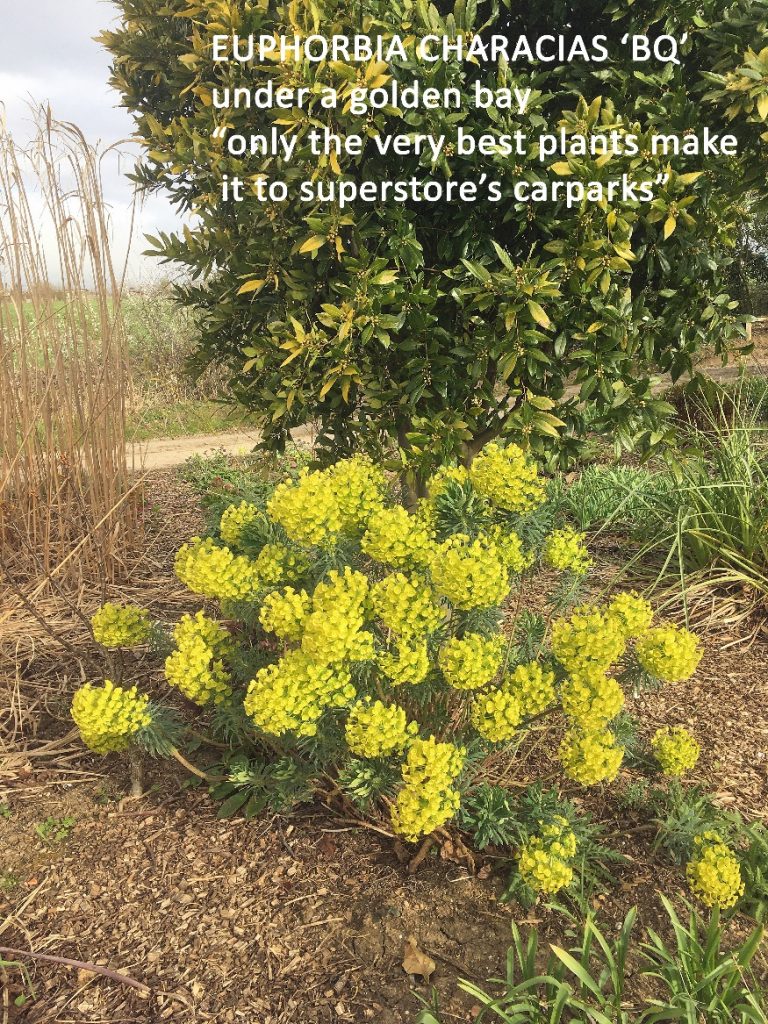
Their shape is a strongly textured ball a metre high with leaves held on the branches like a bottlebrush. If you remember your school geography the Med typically has wet winters and dry summers so they’ve evolved to flower from winter onwards. This is very cheering when even in December the branch tops begin to nod in their growth as a precursor for the formation of the flower heads. The plants last between 3 to 8 years by which time they’re either dead or unprepossessing. They self-seed. On a hot dry August day when you’re seated with a G&T under the apple tree you can hear the ping, ping as the seeds shoot from the dry carapace-like pericarps. The seedlings are easily edited and sometimes a really good form comes up – which has given rise to all those named forms ‘Jimmy Platt’, ‘Blue Wonder’, ‘Lambrook Gold’ and so on. Currently I’m most enthusiastic about ‘BQ’ (my naming). I found this planted on the edge of B&Q’s carpark and left with a radiator valve and some cuttings. I felt the ampersand might have copyright so lost it. The flower heads are impressively yellow. Haven’t I always said that only the very best tried and tested plants make it to superstore’s car parks?
I’ve been through 10 cultivars which are variegated. The foliage on variegated forms is usually cream and grey and the flower heads cream rather than greenish yellow. These variegated forms seem inherently smaller and weaker and generally succumb in winter. I chaired the RHS Trial of Euphorbias for the AGM. This was held at Wisley and every variegated form failed even ‘Silver Swan’ which was a Notcutts variety from Woodbridge in Suffolk. This was reckoned to be tougher than the rest and its failure upset Notcutt retirees who insisted that the plants trialled were not typical. Two years ago, I was given 3 young plants rooted from the original stock to trial myself and I have to say they’ve done well and gone through two winters so far in my terrible alkaline Lias clay soil.
A word of caution. Cover your skin and wear glasses when pruning out dead branches and taking cuttings. I got the milky sap in my eye once and although I recovered soon, the pain was excruciating.
EUPHORBIA AMYGDALOIDES AND EUPHORBIA x MARTINII (THE AMYGDALOIDES X CHARACIAS HYBRID)
Euphorbia amygdaloides (amygdaloid refers to something that’s almond shaped) is a British native plant. I see it growing wild on the roadside every time I drive up Defford Bank heading out of Pershore by Tiddesley Woods. It hybridises easily with E.characias and the hybrid has been named E. x martini.

Included under this group is maybe the most unjustly spurned spurge – Euphorbia amygdaloides var.robbiae (Mrs.Robb’s hat). As I write this on the first of April it’s clothing the ground under a neighbour’s apple tree with bright yellow-green flowers. What’s not to like? It runs but even on clay it’s easily pulled up when it wanders outside it’s purlieu. Few other plants give such effective ground cover in dense dark shade. I applaud Mrs.Robb for feeling positive enough about it to smuggle it out of Turkey under her hat.
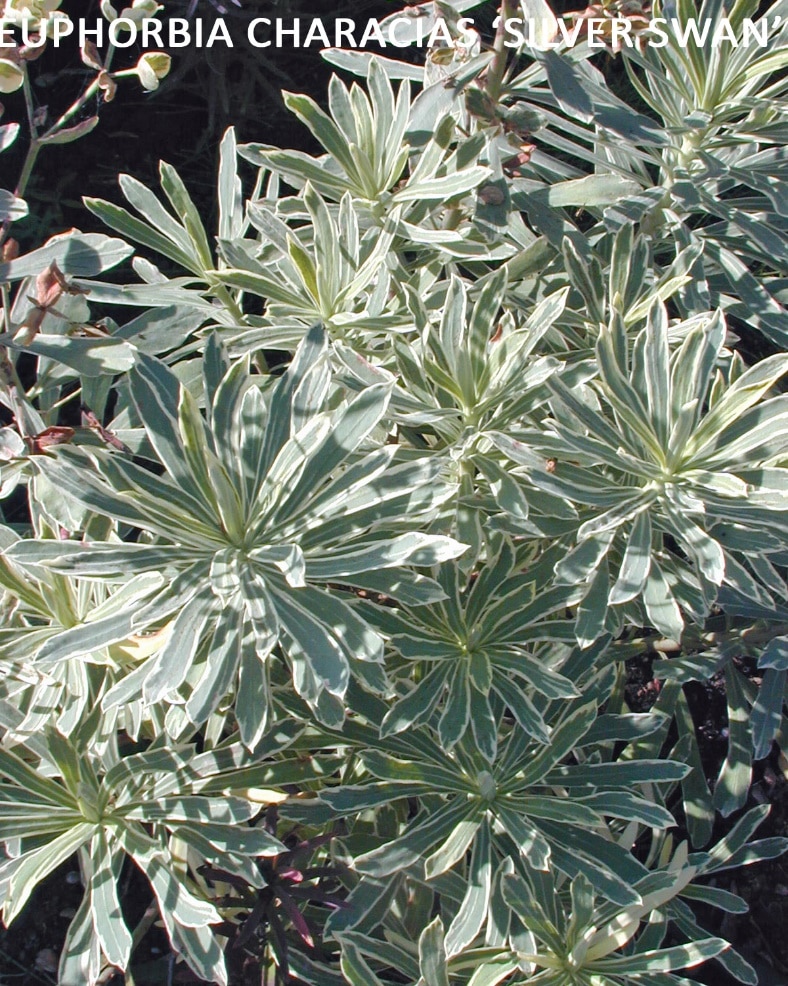
Some of the Euphorbia x martini hybrids run like wood spurge and some do not. My experience of the ‘do notters’ is on the whole not good. ‘Ascot Rainbow’, ‘Blackbird’ and ‘Redwing’ are examples of ones I’ve grown/ continue to grow. Although they’ve fabulous coloured foliage and smaller neater shapes than their E.characias parent they seem to quickly become scratty and die back badly. On the other hand, ‘Helen Robinson’ AGM is a runner and shoots are renewed to hide improvident disorder.
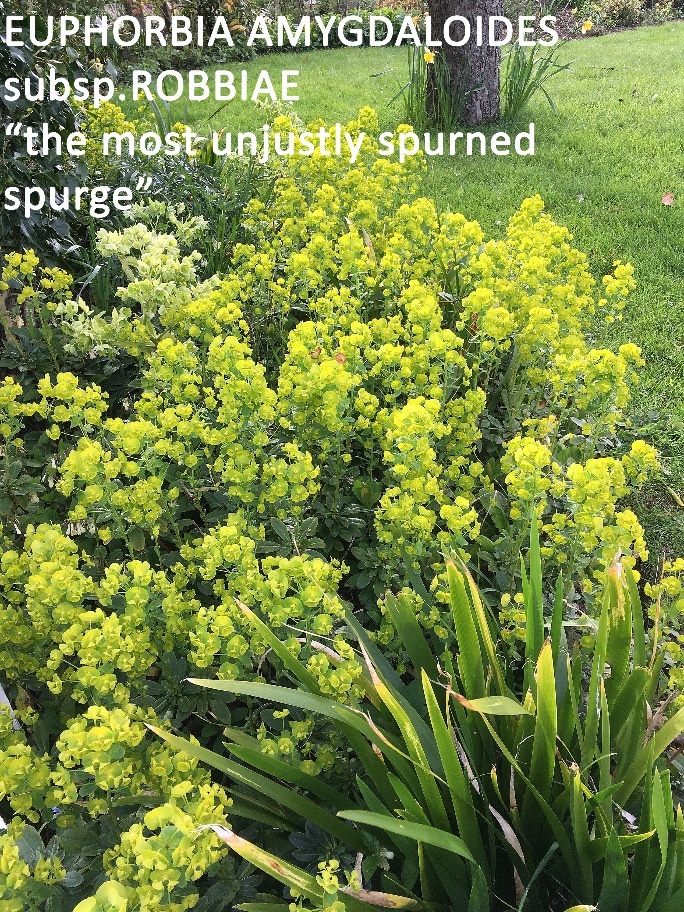
HONEYED HELL
Geographically the Azores are part of Europe and their plants appear in the Flora Europaea. On the other hand, the Canaries and Madeira (Macaronesia) are geographically part of Africa. The floras of both are distinctive and differ from each other markedly. However, there are a few plants they have in common – still different enough to be different species but similar enough to interbreed. So, Euphorbia mellifera from Macaronesia interbreeds with Euphorbia stygiana from the Azores when the two are introduced to each other in gardens. The hybrid is Euphorbia x pasteurii. In the Euphorbia Trial all cultivars of E. x pasteurii like ‘Phrampton Phatty’ and ‘Roundway Titan’ appeared identical. Some complain they get too big. My soil ensures they stay at about 1.5m but for those of you who do battle with their size I’ve discovered that cutting them back to ground level in the winter (and probably at any other time) results in regrowth to only 0.5m. or a third of the height.
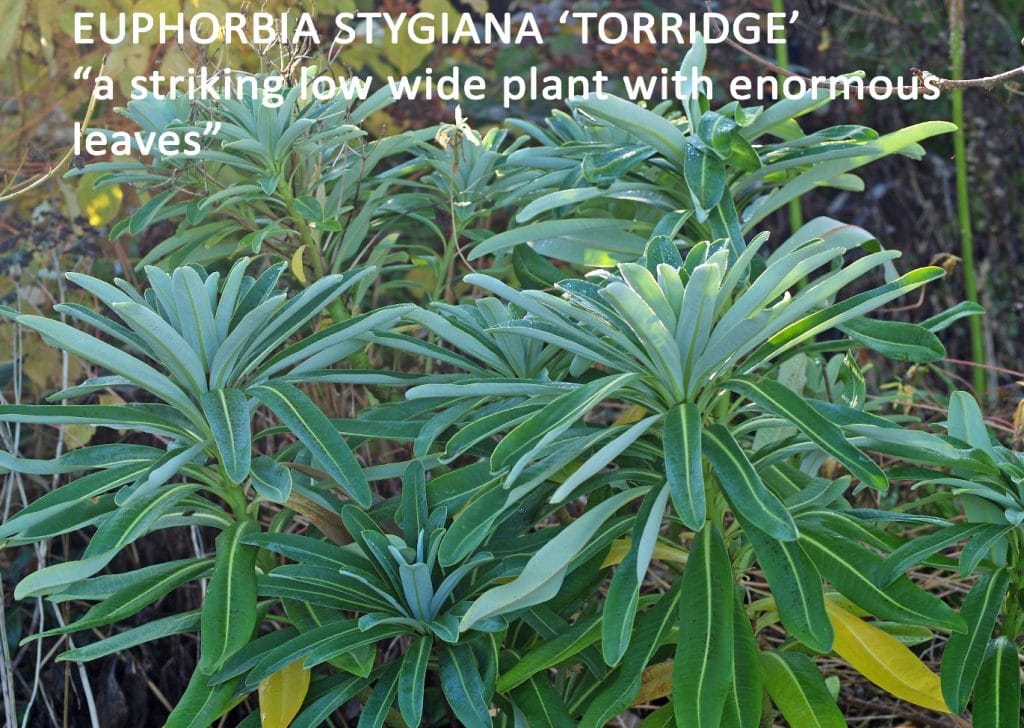
Euphorbia mellifera has no cultivars but Euphorbia stygiana has a few. The subspecies santamaria from the island of Santa Maria is more tree-like and the cultivar ‘Torridge’ collected on the Island of Pico has enormous leaves and is a low and wide plant and is very striking.
HEMICRYPTOPHYTE AND GEOPHYTE FORMS
Most herbaceous plants are hemicryptophytes that is, their overwintering buds are at ground level. Geophytes have their buds below the ground. Up to this point in the discourse all the Euphorbias are technically shrubs.
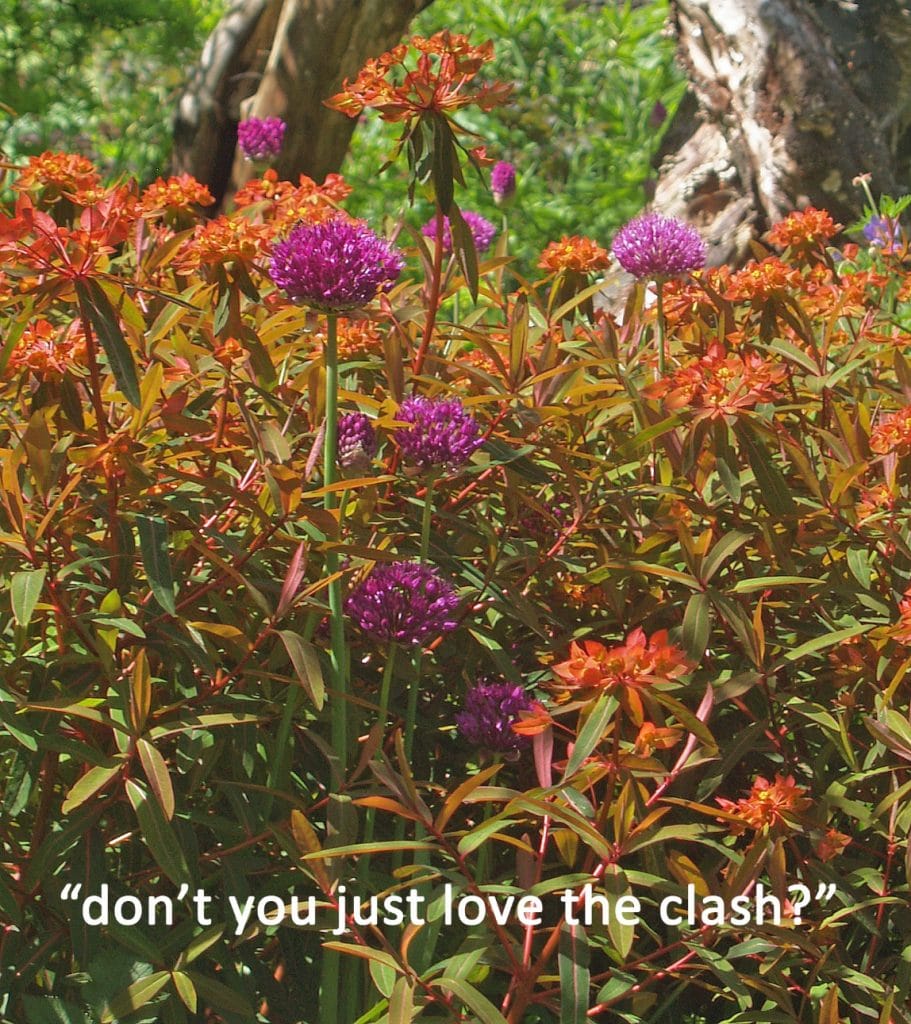

Euphorbia sikkimense is a geophyte and it’s flowers are greenish yellow. So? Are they the only euphorbia with greenish yellow flowers? No. Well, they’re distinctive because they’re greenish yellow in August rather than in spring. This colour in high summer is very welcome in because it cuts through the harlequin palette elsewhere in the garden. I like it’s glassy red shoots in spring too. Euphorbia griffithii is similar with orange shoots in spring quickly followed by orange flowers which clash wonderfully with rich purple alliums. In the autumn the whole plant goes a fiery orange. There are lots of good forms. I like ‘Dixter’ but the one that shone in the Euphorbia Trial was ‘Fern Cottage’. However, neither got an AGM.
Hemicryptophytes include Euphorbia jacquemontii (fabulous eye lined satin-smooth leaves), E.palustris (huge mounds of greenish yellow in early summer) – the best form I’ve discovered being ‘Woodchippings’ with a much more upright habit and astonishing red stems in autumn,
E.cornigera AGM, one of the most commonly grown euphorbias – E. epithymoides which has cushions of bright yellow to only about 30cm in spring and E.dulcis ‘Chameleon’ with deep rufous-purple foliage. This used to suffer from terminal rust infections but seems to have self-selected by self-seeding and is now disease-free.
ROCKERIES AND WALLS
There was a time when every other garden had a rockery. Now they’ve almost disappeared and we have to perch suitable rockery plants on walls or put them at the edge of the border where foot traffic and the mower threaten them. Rockeries meant I might have been able to modify the soil and be able to grow Euphorbia mysinites because it refuses to live in my alkaline clay. Euphorbia rigida which is similar only bigger is more tolerant and I have one plant that was planted in 1992 still going strong. It flowers in winter – wonderful. I can’t say when E.myrsinites flowers because I can’t grow it. I get away with several others in my soil too – Euphorbia nicaeensis which makes a mound of fluffy grey, Euphorbia cyparissias which is ultra-invasive even for me and ‘Blue Haze’. My patches of E.cyparissias on the nursery form solid sheets of fluffy foliage and when in flower give off a very strong perfume. When seen it’s asked for. I deal with all levels of experience. People are warned, really warned but insist on carrying off a piece of clay with the plant embedded in it. They’re told to drop it intact into a hole in their garden and stand back. Maybe these are the kind of people who believe they’re buying euphoria.
THEIR UNIQUE FLOWER STRUCTURE
Sometimes close-up pictures get you to look for the first time. This picture of the flowers of Euphorbia amygdaloides ‘Frosted Flame’ shows a pair of composite flowers each with a pair of flowers (still in bud) arising from them. This set of six flowers is part of a larger flower head. Think of the flower as a dandelion or any other member of what used to be called the Compositae except that here there are no petals. The rings of yellow crescent moons that look like petals are ornamental nectar secreting glands that help give the flowers colour and their honeyed perfume. Every stamen is the vestige of a flower (having a single pedicel surmounted by a contiguous single filament) and there is only one female flower which is red on a red pedicel and hanging down at this stage. This will develop into a 2-seeded fruit from which you might hear the seeds pinging on a still warm dry summer days (when you’re sat with a G&T).


This composite flower head is backed by bracts. These are cream with flashes and flames of green that look wonderful with the red flower stalks. We all know what bracts are on hydrangeas and these are little different except that the flower head together with its attendant bracts is known in euphorbias as a cyathium. It’s certainly odd that two more flowers arise from within the flower (which isn’t actually a flower).
Even the dead flowers on variegated forms are nice. Here are the persistent bracts which remain after the flowers have fallen from this sterile form:

TROUBLE
There are two tender species which I reckon are worth the trouble of growing them, one an annual and one a tender perennial which has to be protected overwinter. That is, Euphorbia marginata which is a naturally variegated annual from N.America. This draws visitors across any garden it’s in.
And, Euphorbia hypericifolia which is a tender perennial from the Caribbean and lands around it. This has clouds of tiny white flowers and although I could bed it out I choose to keep it in a pot which is easier to move inside overwinter. I reckon it needs more winter warmth that just keeping off the frost and its minimum for me is about +5C. It still goes dormant in winter.
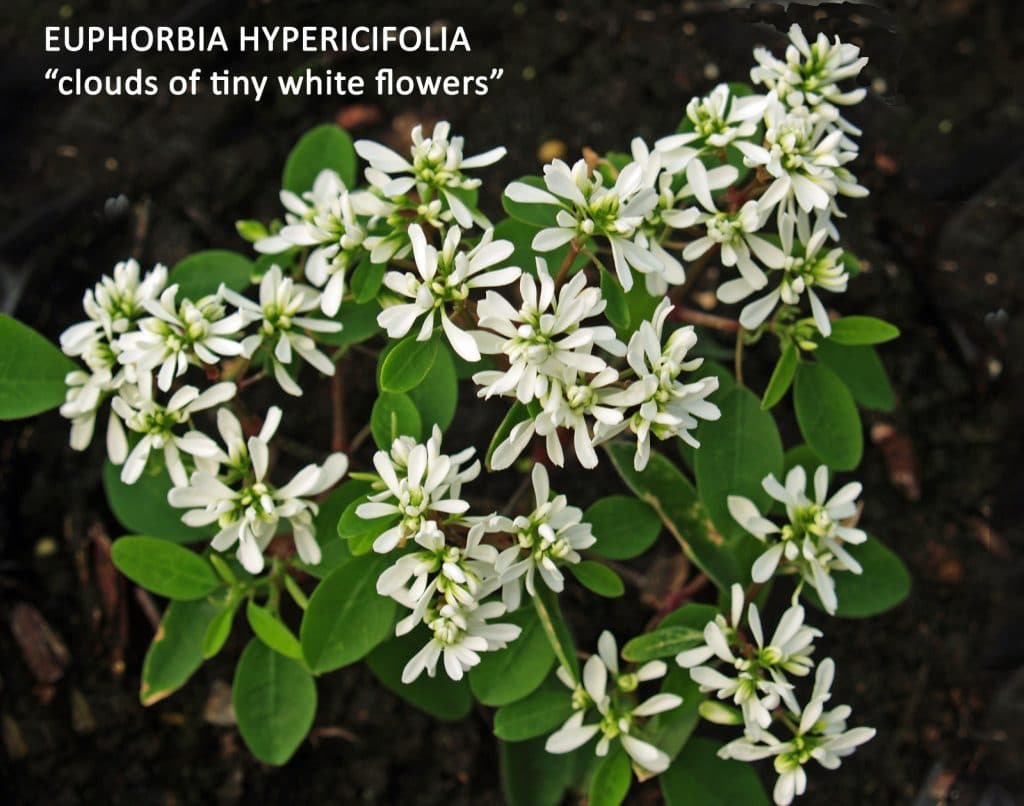
Finally, I must include two ‘shrubby’ species which I wouldn’t be without because both of them flower almost all the year. The first Euphorboa ceratostigma AGM was sold to me in December 1992 by Joe Sharman wo said with luck it would flower all year. In fact, it flowered without stopping till it died in 2002. The second is Euphorbia margalidiana AGM from Minorca. They pretty similar but forced to choose I’d plump for the latter. They have greenish yellow flowers on a yellowish green bush which for me is about 1.5m round – that is both tall and wide. I know they’d be bigger on better soil because planted in recently dug and manured horrible alkaline clay they soar to 2m. round. But keeping my soil in such a state is fugitive.

